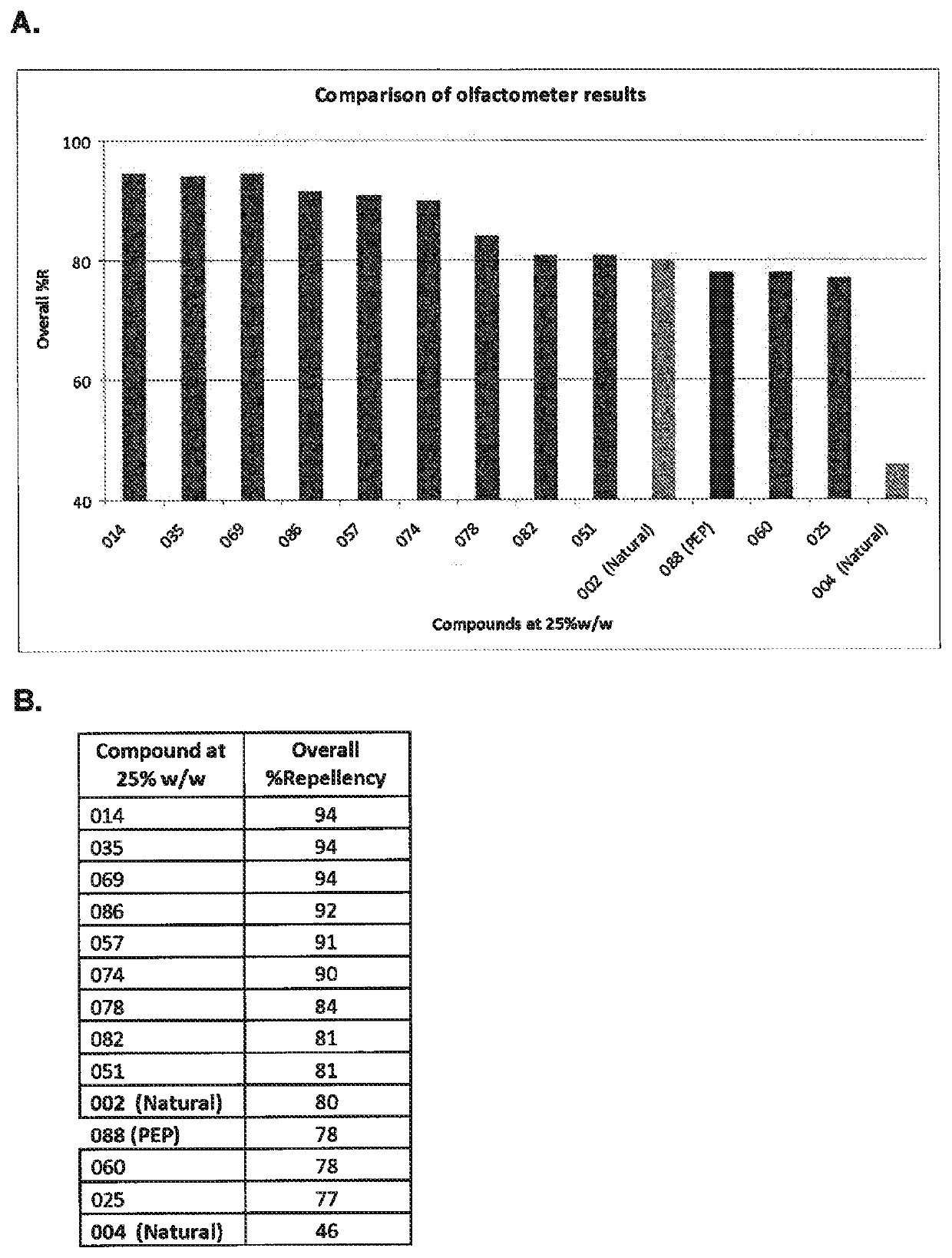Carbonyl containing compounds for controlling and repelling Cimicidae populations
a technology of cimicidae and carbonyl containing compounds, which is applied in the field of pest control, can solve the problems of re-infesting spaces and articles, treatment cannot fully infiltrate the harbourage area of treatment, and consumers' growing resistance to using pesticides in their homes
- Summary
- Abstract
- Description
- Claims
- Application Information
AI Technical Summary
Benefits of technology
Problems solved by technology
Method used
Image
Examples
example 1
Repellency of Compounds of Formula (I) in Bioassays
Test Subjects:
[0149]Per individual bioassay, 10 adult or late instar nymph bed bugs, Cimex lectularius, of mixed sex. Bed bugs sourced from wild, field populations and tested within 2 weeks of capture. Subjects were tested one time, only.
Test Arenas:
[0150]Self-contained test arenas were of one of the following configurations:
[0151](i) Petri Dish arenas consisted of a standard plastic, covered Petri Dish where test substrates were placed at opposite sides of the dish. Dimensions of the dish were 101.6 mm in diameter by 25.4 mm in depth.
[0152](ii) Olfactometer consisting of a glass tube. Tube ends were plugged to prevent egress of test subjects. Test substrates were placed at opposite ends of the tube. Tube Olfactometer includes a port in the centre for introduction of test subjects. Dimensions of the tube were 15.2 mm in diameter by 304.8 mm long.
[0153](iii) Box arenas consisted of covered plastic “Rubbermaid” box where the cover was...
example 2
Repellency of Combinations of Compounds of Formula (I)
[0173]To determine whether compounds could be combined in the repellent compositions, compounds 14 and 35 were each tested at a concentration of 5% (w / w), and as a combination comprising each compound at a concentration of 2.5% (w / w). The formulations were tested as described in Example 1 using the olfactometer configuration. The results are shown in Table 6 and demonstrate that combining the compounds did not adversely affect their repellent activity.
[0174]
TABLE 6Repellency of a Combination of Compounds 14 and 35% R (OverallCompound # (STI-101)Average)Combination I (014 + 035)940359501471
example 3
Formulations of Compound 35
[0175]Compound 35 was formulated as a spray formulation in which the compound was dissolved in isopropyl alcohol (IPA) at concentrations of 1%, 2.5% and 5%.
[0176]In addition, compound 35 was tested on plastic slow-release beads. The beads were cured with either: 1) 20% (w / w) neat compound 35, or 2) 20% (w / w) of a 1:1 mixture of compound 35 and wintergreen oil (methyl salicylate).
[0177]The formulations were tested as described in Example 1 using the box configuration. The results are shown in Table 7 and demonstrate that compound 35 showed excellent repellency in both formulation formats and at all concentrations tested.
[0178]
TABLE 7Repellency of Formulations of Compound 35Concentration ofFormulationCompound 35 (w / w)% R (Overall Average)IPA spray 1%922.5% 94 5%100Plastic beads20%10010% + 10% wintergreen oil 100
PUM
| Property | Measurement | Unit |
|---|---|---|
| time | aaaaa | aaaaa |
| time | aaaaa | aaaaa |
| diameter | aaaaa | aaaaa |
Abstract
Description
Claims
Application Information
 Login to View More
Login to View More - R&D
- Intellectual Property
- Life Sciences
- Materials
- Tech Scout
- Unparalleled Data Quality
- Higher Quality Content
- 60% Fewer Hallucinations
Browse by: Latest US Patents, China's latest patents, Technical Efficacy Thesaurus, Application Domain, Technology Topic, Popular Technical Reports.
© 2025 PatSnap. All rights reserved.Legal|Privacy policy|Modern Slavery Act Transparency Statement|Sitemap|About US| Contact US: help@patsnap.com



